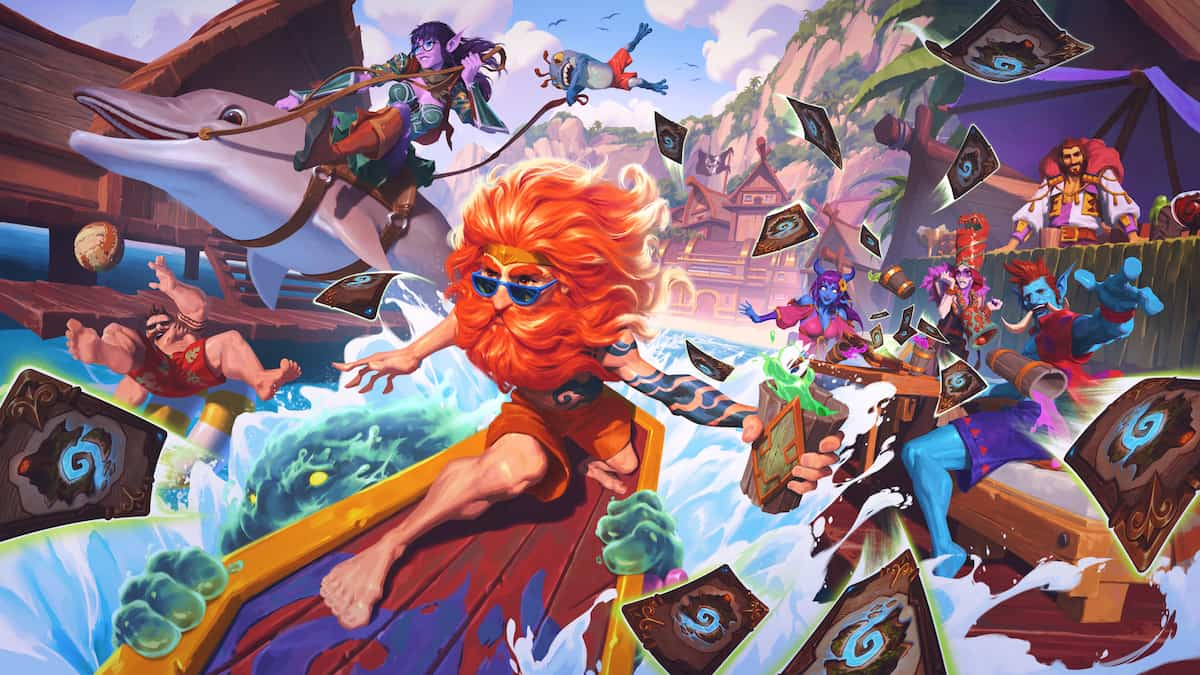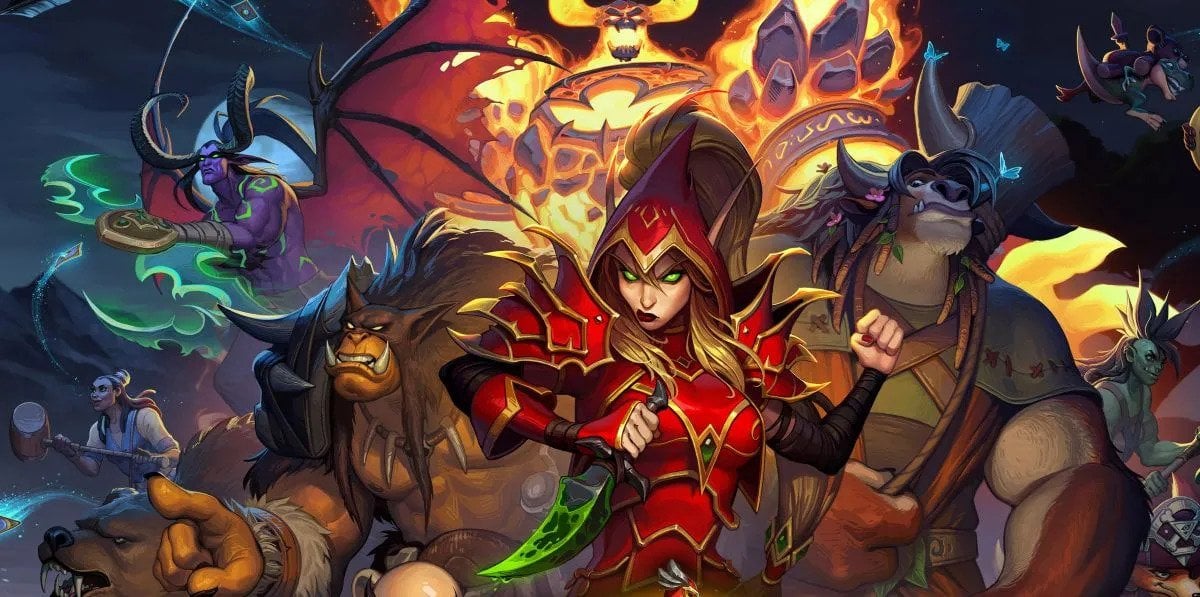Hello and welcome to yet another Flavor Text and Lore article. Stay a while… And read about the story and lore behind some of Hearthstone’s board battlefields – in this case, the capital cities of the Alliance and the Horde.
Known sometimes as “boards”, other times as “battlefields”, these are the scenarios where Hearthstone battles play out, and all are taken from a known locale in Warcraft lore.
Among them are the capital cities of the Horde and Alliance.
The Lay of the Land
Most races in World of Warcraft have their own capital city. In the western continent of Kalimdor, Orgrimmar, sitting on the eastern shore, up on the far northern part of Durotar, is home to the Orcs, though shared by the Trolls – while most Kenzan Goblins stick to its annexed harbour.
Farther inland, travelers can find the Tauren capital, Thunder Bluff, built high up in mountains that touch the skies and dominate the otherwise flat plains of Mulgore.
Almost directly opposite to Orgrimmar, across the continent, Darnassus is the capital the Night Elves formed after the Third War, in the shadow of the new World Tree, Teldrassil, and where the Gilnean Worgen were welcomed once sylvanas-windrunner and her Forsaken laid waste to their kingdom in the name of the Horde.

Sailing south along the coast and then farther to the west, one would arrive to the islands were the Draenei’s dimensional vessel, The Exodar, made its crash landing on Azeroth, before being repaired and converted into the race’s capital.
Across the sea from Kalimdor, in the Eastern Kingdoms, the undead Forsaken, of course, have their own capital in the enormous catacombs underneath the fallen human city of Lordaeron, dubbed “The Undercity”, while far to the north and east sits the rebuilt Silvermoon City, home to the proud Blood Elves.
Far to the south, nested within the mountains in the middle area of the continent that is known as “Khaz Modan”, sits the Dwarven capital of Ironforge, who the earthen people share with their once-neighbours, the Gnomes, driven from their own underground kingdom by radiation and mechanical foes.

And finally, to the south and embracing the western shore of the Eastern Kingdoms, thrives the city-state of Stormwind, the cradle of the Human race.
Of all these, the two greatest are no doubt Stormwind and Orgrimmar, known not only as the capitals of their own races, but also, respectively, or the Alliance and the Horde. These are the two that are represented in the Hearthstone board.
The Kingdom of Stormwind
Sitting at the crown of the lush Elwynn Forest, Stormwind City rules over several human-populated areas: the plains of Westfall, the dark woods of Darkshire, and the Redridge Mountains.
While mostly populated by humans, a healthy dose of all of the Alliance’s races can be found in this capital, drawn by either its bustling trade district, its career military, the Academy of Arcane Sciences (the only wizardly school outside of Dalaran, which is now used as an aerial staging area to fight Azeroth’s enemies and as such is not the most appealing place for novice wizards) or the Cathedral of the Light, the seat of Azeroth’s most widespread religion-philosophy.
Stormwind is ruled by its king, varian-wrynn with the support of his son, the Priest Hero Anduin Wrynn; in the past, a young Anduin was regent along with the paladin bolvar-fordragon due to his father’s disappearance, part of a plot by onyxia to manipulate the kingdom into submission to the Black Dragonflight.

The capital is held as a symbol of human defiance and endurance. It was sacked and destroyed several times in its history: at the end of the First War, its fall marked the Horde’s victory over the Alliance, and its prince was forced to flee with few survivors to the northern human kingdoms.
In the second war, it was retaken by the human armies, and reconstruction started after the Horde had been vanquished. The Third War mostly happened in the northern half of the continent and across the sea in Kalimdor, so Stormwind was mostly uninvolved – though short stories here and there let us know that some support was given to their allies.
Stormwind suffered again in the wake of the cataclysm. Perhaps due to it being the place where the heads his two children – onyxia and nefarian – were hung after their defeat, or maybe simply because it was in his path, deathwing attacked the city shortly after he emerged from his convalescence, laying waste to the entire park district and severely damaging other parts of the city.

So it is no wonder that most of the interactions that one can have with the Hearthstone Stormwind Board are about vandalizing the environment, breaking boxes, shattering windows, etc. The human capital has a history of being broken – and yet, it endures as perhaps the greatest city in Azeroth, rivaled only in majesty and architecture by the Blood Elves’ shining Silvermoon City and the magically-engineered spires of Dalaran.
In the top-left corner of the board, we can see the Cathedral of the Light, seat of the faith that drives most Alliance races. Inside congregate both novice and experienced Paladins and Priests. Absent from the Hearthstone Board is the statue erected in honor to Uther the Lightbringer, the Paladin Hero.
Across from it, in the top-right corner, sits a weapon shop, representative of the many business that dot the city, especially in the Trade District, of which the blue-tiled roof is distinctive, but also in the Dwarven and Old Districts.

Down from it one can find a gryphon roost. For many years, gryphon riding (or the other race’s equivalents) was the absolute fastest way of intra-continental transportation in Azeroth, and the introduction to Stormwind’s gryphon master was the first step in World of Warcraft’s players’ huge quest to travel the Eastern Kingdoms.
These days, the availability of portals and personal flying mounts have lessened their importance somewhat, but they are still quite useful when one wants to take a quick nap while en route, or when flying mounts aren’t readily available.
Finally, the Barracks in the bottom-left corner are where Stormwind’s finest, like stormwind-champion and stormwind-knight, reside. Its clock tower serves actual time-keeping purposes, sounding the bell as the hour turns.

Orgrimmar: Doomhammer’s Legacy
Shortly after drinking the blood of the pit-lord Mannoroth and thus condemning themselves to eternal servitude to the Burning Legion, the orcs saw their homeworld of Draenor quickly wither and die.
Under Gul’dan’s guidance and with Medivh’s help, the Horde invaded Azeroth, wishing to claim the bountiful world to replace their own. They were led by the warchief Blackhand, under who served Orgrim Doomhammer.
Doomhammer was an oddity among the invaders, as he was one of the few who had not drunk the cursed blood. While he was still tainted by the legion’s influence, due to his actions and proximity to his brethren, he did not descend into savagery as easily as most of his people did. He ended up rebelling against his warchief, and taking the reigns of the Horde for himself, conquering Stormwind and ending the First War, but later being beaten back in the Second War.

For many years, he wandered the lands, keeping in touch with the small pockets of orcs who had managed to avoid being imprisoned by the Alliance. Until one day he met Thrall, the Shaman Hero.
Thrall’s father, Durotan, had been Orgrim’s great friend, and as him, has refused to drink Mannoroth’s blood. Later, after travelling to Azeroth with Blackhand’s forces, he was assassinated by Gul’dan’s followers.
Orgrim had assumed Thrall to have met the same fate, but as he saw that was not the case, he quickly took to mentoring the young Shaman, and helping him slowly but surely break their people free from the human internment camps and their dependence on demonical magic.

Orgrim eventually passed away, after fighting bravely during one of the key confrontations – and with his last breath, he gave Thrall both his legendary weapon, the doomhammer, and his armor, elevating him to Warchief of the Horde.
So, after many years wandering Azeroth as refugees and nomads, the Orcs finally found, in the aftermath of the Third War, a place which to call home. A place that their Warchief Thrall named in honor of the Warchief who had held them together through their darkest years, and who had been his friend and mentor up until his death.
The orcish capital was named Orgrimmar.

Orgrimmar has since become the trade hub for all Horde races, connected via wyvern to the rest of the continent, and to The Undercity in far-away Eastern Kingdoms through goblin zeppelins.
The initially rustic architecture was further industrialized and stylized in a more warlike manner by recent Warchief Garrosh Hellscream, the Warrior Hero, and a policy of segregation was enacted, restricting the most important parts of the city to Tauren and Orcs.
This, combined with Garrosh’s war crimes in Pandaria, eventually led to the rebellion that saw both voljin’s Horde and the Alliance, backed by the players, lay siege to Orgrimmar and Garrosh’s “True” or “Iron” Horde. The city was freed from the Warrior Hero’s dictatorship, but his architectural imprint remains.

Unlike the Alliance’s Stormwind board, the Orgrimmar Hearthstone board doesn’t have landmarks in its corners, instead featuring classic Horde structures that proudly display the faction’s tribal and warrior culture.
In the bottom corners, one can appreciate and interact with both a forge and a catapult, while everything else, while not overtly lethal, still displays the spiky, though exterior associated with orcish architecture ever since they arrived in Azeroth as would-be conquerors.
Orgrimmar is named after a fierce, legendary warrior, and it lives up to that name.

Conclusion
I hope you enjoyed this different kind of Lore article – it was originally suggested by reader in this very comment section.
So, by all means, let me know what you would like me to research and write about – I know that some of you have requested adventures, and I’m looking into it.
In the next article, I’ll have a look at some more Legendaries. Stay tuned!





Published: Jan 28, 2016 03:48 pm